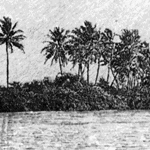Florida Trails
by Winthrop Packard

A travel guide of Florida in 1910 from Jacksonville to Key West during the months of November to April.
Source: Packard, W. (1910). Florida Trails. Boston, Massachusetts: Small, Maynard, and Co.
- Chapter I: “Going South With the Warblers”
- The narrator is surprised when he comes across a myrtle warbler.
- Chapter II: “Certain Southern Butterflies”
- The narrator searches for butterflies.
- Chapter III: “St. Johns River: Along The River Margin”
- The narrator discusses loquat trees, riverbank fishing, and the habitat along the riverbanks of the St. Johns River.
- Chapter IV: “Birds of a Morning”
- The narrator goes on a early-morning bird expedition.
- Chapter V: “‘Twixt Grove and Swamp”
- The narrator discusses the orange groves and how they’ve changed; and the swamps and their surrounding environment.
- Chapter VI: “Jasmine and Cherokee Roses”
- A discussion of the English settlers colonizing Florida.
- Chapter VII: “A Frosty Morning in Florida”
- The narrator describes the effect of frost on the nearby flora.
- Chapter VIII: “Christmas at St. Augustine”
- Through the use of broad imagery, the author describes the effect Christmas in St. Augustine has on him. He imagines Santa Claus’s night and what the nearby trees might be thinking.
- Chapter IX: “In A Florida Freeze”
- The narrator talks of an old bean man who hangs around the sea wall and watches for tourists. He goes on to describe the toll the winter in Florida is taking on the old man (who blames the Northerners for bringing the cold weather).
- Chapter X: “Down the Indian River”
- The narrator describes the birds (in particular the bobolinks and the yellow-billed cuckoo) and their migrating routes. He also talks about the different fruit and trees found along the Indian River.
- Chapter XI: “Spring in the Savannas”
- The narrator describes the different kinds of flora that grow in the spring.
- Chapter XII: “Seven Thousand Pelicans”
- The narrator describes the pelican from his physical features to mating habits.
- Chapter XIII: “Just Fishing”
- The narrator dreams of spending the rest of his days where he can fish from hand-made fishing poles. He goes on to explain how to make a proper fishing pole.
- Chapter XIV: “Palmettos of the St. Lucie”
- The narrator talks about making a brush fire when the weather is dry in order to clear the way for new trees. He also describes how you can see the palmettos from the St. Lucie River, anything and everything involving palmettos.
- Chapter XV: “Intruding on Ward’s Herons”
- The narrator describes the Ward’s heron and his experiences looking for them.
- Chapter XVI: “One Road to Palm Beach”
- The narrator describes the musk-melons that can be found to the west of the Indian River. He goes on to describe the day he was taken on a road that led to Palm Beach and his experiences there.
- Chapter XVII: “Moonlight and March Mornings”
- The narrator describes the moonlit nights leading up to March and thereafter.
- Chapter XVIII: “In Grapefruit Groves”
- The narrator explains the history of grapefruit. He describes the types of birds that frequent the groves and the other animals that can be found in the lush greenery of the grapefruit groves.
- Chapter XIX: “Butterflies of Indian River”
- The narrator describes the flora surrounding the Indian River, the types of fish that exist there, and the different butterfly species.
- Chapter XX: “Alligators and Wild Turkeys”
- The narrator describes the areas westward of the St. Lucie River. He goes on to talk further about the alligators who live there and ways to hunt them. He also describes the wild turkeys and their habits.
- Chapter XXI: “Easter at Palm Beach”
- The narrator describes Palm Beach as “a gem in a jungle.”
- Chapter XXII: “Into the Miraculous Sea”
- The narrator discusses Palm Beach, the pioneers, and the ocean.
- Chapter XXIII: “Down the St. Johns”
- The narrator describes the land along the St. Johns River in full detail.
- Chapter XXIV: “Holly Blossom Time”
- The narrator talks of the Holly Tree during different seasons.
- Chapter XXV: “In a Turpentine Camp”
- The narrator describes a negro man who works in a pinery and turpentine camp.
- Year Published: 1910
- Language: English
- Country of Origin: United States of America
-
Readability:
- Flesch–Kincaid Level: 9.5
- Word Count: 66,327
- Genre: Informational
- Keywords: nature, travel, travelogue